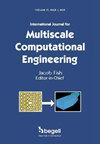基于注意力特征和交叉平均池的肺部感染识别端到端深度学习框架
IF 1.4
4区 工程技术
Q2 ENGINEERING, MULTIDISCIPLINARY
International Journal for Multiscale Computational Engineering
Pub Date : 2022-02-01
DOI:10.1615/intjmultcompeng.2022041262
引用次数: 0
摘要
肺炎、流感、支气管炎、冠状病毒(COVID - 19)等疾病是一些主要的呼吸道感染,在全球造成重大影响,导致世界各地的残疾和死亡。结合计算机视觉,通过医学成像自动检测肺部感染,有望改善针对COVID-19的医疗保健及其后果,因为医疗紧急情况有限。由于邻近组织相似、边界模糊和感染不可预测,很难从肺部x线和CT图像中发现受影响的组织并对其进行分割。为了克服这些问题,我们提出了一种新的深度学习框架,该框架采用基于注意力的特征向量和交叉平均池来从图像中检测肺部感染。增强后的多模态图像通过预训练的DenseNet独立处理,其中从完全连接和平均池化层进行特征提取。它不是为特征向量中的每个特征值分配相等的权重,而是为每个特征分配一个关注权重,以突出应该对其给予多少关注。然后使用交叉平均池化方法将获得的基于注意力的特征融合在一起,产生一个区分特征集,从而提高诊断。将融合的特征通过一种改进的深度学习神经网络分类器进行诊断。在标准Kaggle和Mendeley数据集上进行了实验,结果表明平均准确率为99.2%,kappa指数和F1-Score均有明显提高。我们的呼吸道感染分类DL方法的结果本文章由计算机程序翻译,如有差异,请以英文原文为准。
An End-End Deep Learning Framework for lung infection recognition using Attention-based features and Cross average pooling
Diseases like pneumonia, influenza, bronchitis, corona virus (COVID – 19) are some of the major respiratory infections that have made a major impact globally leading to disability and death around the world. Automated detection of lung infections from medical imaging combined with computer vision has a lot of promise for improving healthcare towards COVID-19 and its consequences due to restricted healthcare emergencies. Finding the affected tissues and segmenting them from lung X-ray and CT images is difficult due to comparable neighbouring tissues, hazy boundaries, and unpredictable infections. To overcome these issues, we propose a novel deep learning framework that employs attention-based feature vectors and cross average pooling to detect the lung infection from the images. Multimodal images, after enhancement are processed independently through a pretrained DenseNet where the feature extraction is performed from fully connected and average pooled layers. Instead of assigning equal weight to each feature value in the feature vectors, an attention weight is assigned to each feature to highlight how much attention should be paid to it. The obtained attention-based features are then fused using cross average pooling method to produce a discriminatory feature set leading to improved diagnosis. The fused features are passed through a proposed deep learning modified neural network classifier to diagnose the repository infection. Experiments are performed on the standard Kaggle and Mendeley datasets and the results indicated an average accuracy of 99.2% with appreciable Kappa-index and F1-Score. The results of our DL method for categorising respiratory tract infections we
求助全文
通过发布文献求助,成功后即可免费获取论文全文。
去求助
来源期刊
CiteScore
3.40
自引率
14.30%
发文量
44
审稿时长
>12 weeks
期刊介绍:
The aim of the journal is to advance the research and practice in diverse areas of Multiscale Computational Science and Engineering. The journal will publish original papers and educational articles of general value to the field that will bridge the gap between modeling, simulation and design of products based on multiscale principles. The scope of the journal includes papers concerned with bridging of physical scales, ranging from the atomic level to full scale products and problems involving multiple physical processes interacting at multiple spatial and temporal scales. The emerging areas of computational nanotechnology and computational biotechnology and computational energy sciences are of particular interest to the journal. The journal is intended to be of interest and use to researchers and practitioners in academic, governmental and industrial communities.

 求助内容:
求助内容: 应助结果提醒方式:
应助结果提醒方式:


